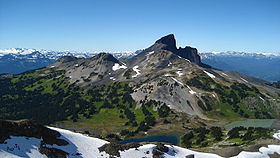The Black Tusk
| The Black Tusk | |
|---|---|

The Black Tusk viewed from the southeast
|
|
| Highest point | |
| Elevation | 2,319 m (7,608 ft) |
| Prominence | 569 m (1,867 ft) |
| Coordinates | 49°58′31″N 123°02′34″W / 49.97528°N 123.04278°WCoordinates: 49°58′31″N 123°02′34″W / 49.97528°N 123.04278°W |
| Geography | |
|
|
|
| Parent range | Garibaldi Ranges |
| Topo map | NTS 92G/14 |
| Geology | |
| Age of rock | |
| Mountain type | Stratovolcano |
| Volcanic arc/belt | Canadian Cascade Arc Garibaldi Volcanic Belt |
| Last eruption | |
| Climbing | |
| First ascent | 1912 by William J. Gray and party |
| Easiest route | Exposed rock scramble |
The Black Tusk is a stratovolcano and a pinnacle of volcanic rock in Garibaldi Provincial Park of British Columbia, Canada. At 2,319 m (7,608 ft) above sea level, the upper spire is visible from a great distance in all directions. It is particularly noticeable from the Sea-to-Sky Highway just south of Whistler, British Columbia. Distinctive and immediately identifiable, The Black Tusk is among the best known mountains in the Garibaldi Ranges of the Coast Mountains. The volcano is part of the Garibaldi Volcanic Belt which is a segment of the Canadian Cascade Arc, but it is not within the geographic boundary of the Cascade Range.
To Squamish people, this mountain is known as t'ak't'ak mu'yin tl'a in7in'a'xe7en. In their language it means "Landing Place of the Thunderbird", speaking of the supernatural in7in'a'xe7en or Thunderbird. The jagged shape of the mountain and its black colouring are said to come from the Thunderbird's lightning. The same is true for Mount Cayley, another stratovolcano farther north.
The Black Tusk is considered to be the remnant of an extinct andesitic stratovolcano which formed between about 1.3 and 1.1 million years ago. Following glacial dissection, renewed volcanism produced the lava dome and flow forming its summit about 170,000 years ago. According to Natural Resources Canada, The Black Tusk was "perhaps the conduit for lava within a cinder-rich volcano. The loose cinder has eroded, leaving only the hard lava core." The exposed lava rock of the core is loose and friable. It is also black, giving the mountain its name and character. Cinder Cone, to the east of The Black Tusk, produced a 9 km (6 mi) long lava flow during the late or early Holocene.
...
Wikipedia

